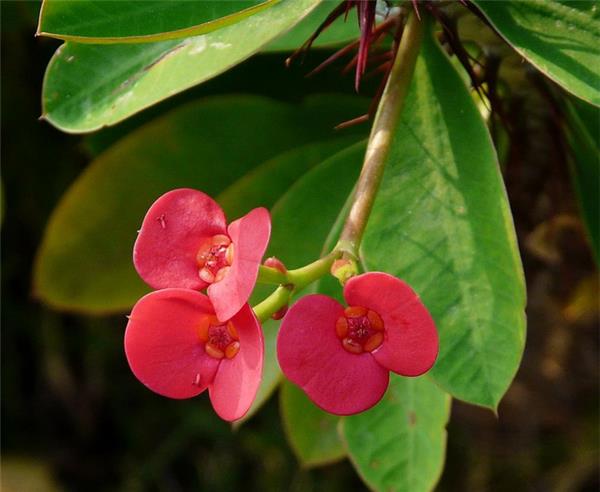Is tiger thorn plum poisonous?
Rosa roxburghii is a kind of plant with beautiful flower shape and eye-catching color, which can beautify the room and purify the air when placed at home, so is it poisonous?

Is tiger thorn plum poisonous?
Tiger prickly plum has thorns all over the body, and it will flow out white milk after being injured. This kind of milk is toxic and will have a certain irritating effect on the skin and mucous membrane of the human body. If the human body eats by mistake, it will cause certain problems such as leakage, vomiting, dizziness and so on. So the tiger thorn plum planted in the family should be stored well, so as not to cause children to eat by mistake.
In fact, although the milk of water tiger thorn plum is poisonous, but its flower branches and stems can be used as medicine, and its nature is cool and bitter. There's a little poison. It has the effect of removing poison and relieving fire, cooling blood and stopping bleeding.
In addition, tiger thorn plum is one of 52 cancer-promoting plants confirmed by relevant experts, so it is recommended not to plant it. The study found that tiger thorn plum carries "poison" all over its body. Prunes emit an unpleasant, pungent smell, and initiators containing carcinogenic viruses and chemical carcinogens have been detected in soils that have been planted with such plants. According to experts, cancer-promoting plants such as prickly plum contain "Epsteln-Barr virus early antigen inducers", which can induce EB virus to transform lymphocytes and promote tumor growth caused by tumor viruses or chemical carcinogens.

Next, let's take a look at the relevant introduction of tiger thorn plum.
Introduction of tiger thorn plum
Tiger thorn plum, also known as unicorn thorn, iron begonia, is a kind of vine edge prickly plant. Although it is said that there are thorns on the edge of the tiger thorn plum, it does not affect the mood of people to like it at all. On the contrary, it has increased the love of many people because of the thorns in the appearance of the tiger thorn plum. Under the condition of temperature guarantee, tiger thorn plum can basically blossom all the year round and is one of the most popular ornamental plants.
Tiger thorn plum flowers are generally dark red or yellow, the flowers are relatively small, generally grow in pairs or in small clusters, with a unique gorgeous beauty, dazzling the heart.

The efficacy and function of Prunus mume
1. Prunus angustifolia is a kind of characteristic plant with high ornamental value. It has a long flowering period and red bracts after flowering. The color is beautiful and attractive. The stem of tiger thorn plum is relatively soft and can be tied into a variety of beautiful and moving shapes, which is the favorite decorative plant in some hotel shopping malls.
2. Prunus angustifolia has the function of preventing and curing aphids and red spiders. Its stems, flowers, branches and leaves can be used as medicine. It is a kind of traditional Chinese medicine with cold nature and bitter taste. When people use it, it has the important effect of cooling blood and stopping bleeding to expand and remove poison and remove fire.
3. Chimonanthus przewalskii is a kind of poisonous plant, there is toxin in the whole plant, and white juice flows out after breaking its stem, which is a kind of huge toxic substance, which can cause serious irritation when it comes into contact with human skin. if you eat it carelessly, there will be adverse symptoms such as nausea and vomiting, as well as diarrhea, so when raising tiger prunes, you should keep it away from children.
4. In recent years, scientists have done further research on this plant, and found that the toxin of this plant has a great inducement to human cancer, so we should avoid planting it indoors as far as possible. Usually when raising tiger thorn plum, we should also try to reduce the contact between this plant and the human body, otherwise the toxin enters the human body, which is particularly disadvantageous to health.

After reading the introduction above, do you know how to answer the question of whether the tiger prickly plum is poisonous?
Related
- Wuhan Hospital Iron Tree Blooming Result Was Instantly Frightened by the Gardener Master
- Which variety of camellia is the most fragrant and best? Which one do you like best?
- What is the small blue coat, the breeding methods and matters needing attention of the succulent plant
- Dormancy time and maintenance management of succulent plants during dormancy
- Minas succulent how to raise, Minas succulent plant pictures
- What are the varieties of winter succulent plants
- How to raise succulent plants in twelve rolls? let's take a look at some experience of breeding twelve rolls.
- Attention should be paid to water control for succulent plants during dormant period (winter and summer)
- Watering experience of twelve rolls of succulent plants
- Techniques for fertilizing succulent plants. An article will let you know how to fertilize succulent plants.



